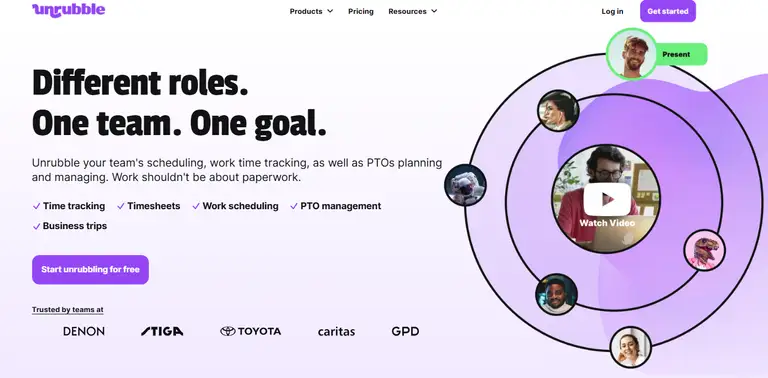Measuring how your team works has never been easy. In 2026, with remote work, artificial intelligence and new workplace expectations, the challenge is even greater.
As someone who studies productivity and works at Unrubble, I often think about the journeys I’ve seen: small companies grow, people learn new roles and leaders rethink old habits.
In this article, I share my findings with business leaders like you who want to calculate employee productivity and keep their people happy.
I will use examples from my own experience as well as data from recent research.
Why modern employers should measure productivity
When I first joined an HR team years ago, I assumed productivity was just about output. Later I learned that it also touches morale, engagement and revenue.
Studies show that employee satisfaction and engagement are linked with productivity. For example, a Gallup study found that business units with high employee engagement had a 21% improvement in productivity over those with lower engagement. Another survey highlighted by Forbes reported that happy workers are about 13% more productive.
These findings match what I see: teams with a positive attitude finish more tasks and produce better results. Programs supporting work-life balance not only help mental health but they also promote productivity and reduce turnover. A healthy balance helps employees focus, and companies that invest in balance often report higher productivity.
- Measuring productivity brings clarity.
- It lets managers make data‑driven decisions about hiring, compensation and training.
- It also helps to identify bottlenecks, broken equipment or inefficient processes.
- Without measurement, it is hard to track progress or understand which actions have a positive impact on output.
In my work with clients, I have seen employers make changes based on metrics like revenue per hour or tasks completed, and the results were remarkable.
Understanding the basic formula to calculate productivity
The classic formula for labor productivity is simple:
Labor productivity = total output ÷ total hours worked.
The U.S. Bureau of Labor Statistics (BLS) defines labor productivity as output per hour, calculated by dividing an index of real output by an index of hours.
Another BLS publication notes that this ratio can be expressed as labor productivity = (output index) / (hours of labor input). This formula works across industries, from manufacturing to services.
For example, if your marketing team completes 2 000 tasks in 500 hours, productivity would be 4 tasks per hour. If a call‑center team finishes 50 campaigns in 200 hours, the productivity rate is 0.25 campaigns per hour. Such ratios help you compare performance between teams and track trends over time.
The general principle remains the same even when output is measured in revenue or services produced. You can divide output (revenue generated or units produced) by hours worked to get a productivity rate. This simple metric is the foundation for more complex calculations and serves as a key metric for operations management.
Productivity rate examples
Tasks completed per hour:
In a business process outsourcing (BPO) setting, a productivity rate might be calculated as Total Completed Tasks ÷ Total Hours Worked. A hypothetical example from a BPO guide suggests that completing 6.9 tasks in 8 hours yields a productivity rate of 86.25%.
Units produced per hour:
Manufacturing managers often aim for a productivity rate of 70–75% because it means employees spend about 70% of their time on tasks. This ratio helps them plan staffing and training.
Revenue per person:
In retail or services, dividing sales revenue by total hours or by the number of employees gives insight into how well labour is being used.
Moving from single‑factor to multifactor productivity
While the labor productivity formula looks only at hours, multifactor productivity (MFP) accounts for other resources.
According to BLS news releases, multifactor productivity is calculated by dividing an index of real output by an index of combined inputs such as labor and capital services.
Sometimes you'll also see that MFP = output ÷ (weighted labor + weighted capital + other inputs). In practice, this means including equipment, software, and even energy use. MFP gives a more complete picture in complex operations where technology and capital play large roles.
For example, if a factory produces 10 000 units using 2 000 hours of labour and €50 000 worth of machinery, managers might assign weights to each input and compute productivity accordingly.
Although this method is more complicated, it helps to identify where to invest: for instance, whether to hire more people, update machinery, or train staff.
Modern key metrics and techniques to increase employee productivity
In 2026, measuring productivity goes beyond counting widgets. Employers consider both quantitative and qualitative metrics:
Output generated: tasks completed, units produced or revenue generated. Tracking this helps to see trends over a specific period and to compare teams.
Hours spent and activity data: collect data from time‑tracking systems to see how long tasks take. Tools like Unrubble give detailed time tracking and AI‑powered analytics. I have used Unrubble’s own time tracking tool with clients - it helps them see when employees work, which applications they use, and whether tasks are on schedule.
Quality of output: measure error rates, customer satisfaction or defects. Work done offsite can include fewer mistakes, which shows that quality and productivity are related.
Employee satisfaction and engagement: Gallup’s research links high engagement to a 21% increase in productivity. Companies that invest in engagement outperform peers in productivity, profitability, and retention. Programs that support work-life balance and positive psychology also help. One survey found that happy employees are as much as 20% more productive.
Work-life balance: giving employees flexibility improves concentration. Companies with work-life balance programs report increased productivity. I have seen remote workers deliver consistent results while maintaining family commitments. Hybrid work can reduce distractions and result in higher productivity compared to in‑office.
Employee experience and well‑being: positive work environments encourage commitment. Engagement creates a feedback loop where employees who are more engaged perform better and produce more. At Unrubble, we notice that employees who share feedback and feel a sense of appreciation tend to stay longer and accomplish more.
Calculate employee productivity using these qualitative methods
Numbers only tell part of the story. Employers also use surveys, peer reviews and 360-degree feedback to measure workplace productivity. These methods capture traits like innovation, problem solving and collaboration.
For example:
Self‑assessment journals: ask employees to record tasks completed, challenges faced and ideas. This helps managers see hidden work such as mentoring or brainstorming.
Peer feedback: colleagues can comment on timeliness and teamwork. Because peers see day‑to‑day activities, their feedback often reveals insights that metrics miss.
Customer or client surveys: quality of service often affects productivity. High customer satisfaction may mean employees are efficient.
Combining these qualitative methods with quantitative data creates a complete picture and helps you make fair comparisons across individual employees and teams.
The impact of AI and remote work on measurement
Artificial intelligence is reshaping productivity measurements. Tools now use machine learning to analyse patterns and predict workloads.
For instance, many remote‑work predictions note that AI and automation are revolutionising remote work by smoothing workflows. 69% of managers believe hybrid or remote work has improved productivity, and 80% of employees have used or tested AI in their work.
Data from cross‑over studies show that 91% of remote workers report equal or higher performance and 78% of managers see their teams meeting goals.
These trends mirror my experience at Unrubble.
AI‑based tools can also learn from historical data to predict when employees might need support or training. However, the goal is not to spy on people but to generate valuable insights that help employers and employees alike.
When used responsibly, AI can help build trust and support fairness. For instance, by spotting repetitive tasks, managers can automate them and free people for creative work.
How to improve productivity with Unrubble and other tools
During my tenure at Unrubble, I’ve learned that measurement alone does not change habits. You need the right tools.
Our platform combines time tracking, scheduling, timesheets, business trips management, and more. It captures employee activity data without being intrusive.

For instance, if a team member spends many hours on repetitive tasks, Unrubble flags this so a manager can reassign tasks or automate them. This not only helps the employee but also improves the company’s overall output.
Clients tell me that after they started using our tool, they saw fewer missed deadlines and better allocation of labour.

The role of business leaders and HR departments
As a business leader, your job is to connect employee experience with business goals. HR departments should work with managers to track key metrics, run surveys and communicate findings.
They must also respect privacy and use data ethically. By being transparent about why you collect data and how you use it, you build trust.
When employees understand that the goal is to improve work conditions and recognise achievements, they are more likely to participate.
Leaders should also invest in professional development.
In my career, I have seen people move from front‑line roles to leadership by learning operations management, strategic planning and people skills.
Encouraging continuous learning keeps the organisation adaptable. Use the metrics you gather to personalise training and monitor progress over time.
Looking ahead: employee experience in 2026 and beyond
The workplace will keep evolving. Remote and hybrid arrangements are here to stay, AI will become more common, and employees will demand more flexibility.
When I think of the future, I imagine workplaces that value output and well‑being equally. Tools like Unrubble will continue to help managers see what is happening, but the human touch (listening, mentoring and celebrating achievements) will remain key.
If you measure employee productivity thoughtfully and act on what you learn, you will not only improve results but also create a place where people enjoy working.
If you're ready to start now, try Unrubble for free.
FAQ: measuring employee productivity in 2026
How do you measure productivity in the service industry?
In the service industry, productivity is often measured based on the output produced during a specific time period. This could mean completed client requests, resolved tickets, or revenue per hour. Since outputs vary depending on the service type, it’s important to use both quantitative and qualitative indicators like customer satisfaction and response time.
What is workforce productivity?
Workforce productivity refers to how efficiently a company’s employees turn their time spent and resources into results. It measures overall team performance, helping business leaders understand how well people contribute to the company’s goals.
Why do successful organizations measure productivity?
Successful organizations measure productivity because it helps them make data-driven decisions, identify areas for improvement, and create actionable strategies to increase productivity. With a solid understanding of their metrics, leaders can spot inefficiencies and build stronger, more motivated teams.
How can companies boost productivity among employees?
Companies can boost productivity by improving employees’ performance through flexible scheduling, fair workload distribution, and modern time-tracking tools. When employees feel supported and trusted, they perform better and deliver higher-quality results.
What affects average productivity across teams?
Average productivity can vary depending on skill level, available tools, and motivation. Tracking factors like time spent, output produced, and engagement helps managers identify what drives higher performance.
How do you track productivity effectively?
To track productivity, use tools that record working hours, task completion, and progress over a set time period. For example, Unrubble’s time tracking helps companies see where resources go and how to improve company’s productivity over time.
What are actionable strategies to increase productivity long-term?
Practical steps include:
- Encouraging feedback and collaboration.
- Setting clear goals for each time period.
- Monitoring workloads to reduce burnout.
- Investing in skill development.
When applied consistently, these actionable strategies create a culture of continuous improvement and higher workforce productivity.








